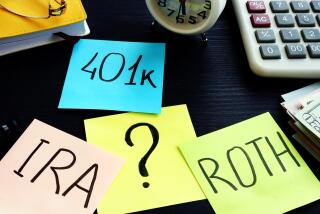Robinhood launches retirement accounts for gig workers

- Share via
Robinhood, the company that blazed onto Wall Street after turning millions of novices into investors by making trading fun, is now setting its sights on a more staid corner of the industry: saving for retirement.
The company on Tuesday is initiating signups for a retirement program, where customers can sock savings into an Individual Retirement Account, something better known as an IRA.
It’s the first such effort for Robinhood, which is trying to recapture some of the high-flying growth that fell off as painful downturns made day-trading of stocks and cryptocurrencies much less fun.
Robinhood has often appealed to younger customers, and many of them are working jobs that don’t have access to a traditional 401(k) retirement plan offered by an employer, said Vlad Tenev, Robinhood’s chief executive.
Such 401(k) accounts have been instrumental in getting millions of Americans to save for retirement, with many workers getting enrolled automatically by their employer. But many of Robinhood’s customers are in parts of the job market that don’t get the luxury of such programs.
Robinhood announced plans for an IPO one day after the company settled regulatory charges that should make the average customer or investor wonder.
“Today, you’re seeing an increasing number of people doing contract work, part-time work, gig-economy work,” Tenev said in an interview. “They just don’t have access. We wanted to bring that to everyone, no employer needed.”
Robinhood is promising to match 1% of eligible contributions that customers put into their IRA. That could mean up to $65 for someone who contributes the maximum allowed $6,500 to an IRA next year. People aged 50 and over can contribute up to $7,500 in 2023.
Early signups will get access to Robinhood’s IRAs over the coming weeks, with the program becoming fully available in January.
A retirement program is something that Robinhood’s customers have long been requesting, Tenev said. And it’s something that could significantly boost Robinhood’s bottom line.
Retirement savers can be less prone to move between different brokerages, and retirement savings offer a huge potential market.
They’re comfortable with stock trading apps such as Robinhood and Webull and teaching themselves finance on the fly, hoping to propel themselves and loved ones into a better life.
Total U.S. retirement investments totaled $33.7 trillion this summer, according to the Investment Company Institute. They account for 31% of all household financial assets. IRAs make up the biggest single chunk of that, at $11.7 trillion.
Growth for Robinhood has slowed sharply since its popularity took off through the pandemic. Its stock has fallen roughly 45% this year and is below $10 after hitting a peak above $70 shortly after its stock-market debut in the summer of 2021.
Its growth hit a zenith in the first half of 2021, when the new generation of investors it helped convert was a major factor in the meme-stock frenzy that sent GameStop and others to market-bending heights.
But the meme-stock craze has since calmed. So, too, has crypto trading, another big source of revenue for Robinhood.
One reason for the GameStop explosion was the number of traders at Robinhood and other brokerages that were using stock options to ride the wave. In some cases, trading options can increase the possible reward if a trader is correct but can also increase the risk.
Tenev said Robinhood’s retirement customers won’t be able to trade options in their IRAs, as some other providers allow, at least not yet.
“On Day 1, they won’t,” he said. “It’s only going to be stocks and ETFs. We’re going to be looking at feedback and will look to add assets.”
More to Read
Inside the business of entertainment
The Wide Shot brings you news, analysis and insights on everything from streaming wars to production — and what it all means for the future.
You may occasionally receive promotional content from the Los Angeles Times.












